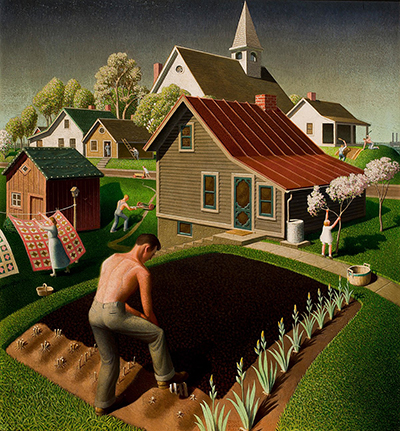Spring in Town depicts a small town with visible houses and people participating in various duties in the background. The art displays a peaceful, homely, lovable and dedicated town to preserve its worthiness.
The artist painted Spring in Town in 1941, and it was one of his last two paintings. The art was one of the most loved, and it was acquired by Swope in 1941, months before the Swope Art Museum was launched. The country's landscape was changing at a first-rate at the time of the creation of the painting; thus, it demonstrated nostalgia for rural America. The scene has industrial smokestacks and gardens in the backyard as in the Great Depression and during the war as victory gardens.
The art captured the ordinary lives of typical rural Americans with a shirtless youthful man gardening to prepare for spring planting, female hanging quilts on the cloth line to dry, a man climbing a ladder to his roof and a child pushing a cart. Grant Wood painted the scenes in a crispy manner and clear lines to create a vivid perception of what was going on; thus, creating the ability to see a panorama of the small town's lifestyle and labour.
Themes Depicted in Spring in Town Portrait
Spring in Town depicts the American way of life before World War II. The scene conveys a happy fantasy of daily American life after the United States entered the war. The two boys in the right background side of Spring in Town are involved in the common task of beating a rug. The other individuals in the portrait pursue their respective activities bringing forth a theme of individualism in both work and play. The church overlooking the clean neighbourhood of the single-family houses depicts the religious orientation of the people. Additionally, the factory at the far end in the upper right depicts the region's industrialisation.
Inspirations for the Painting
The artist was determined to fulfil his intention of promoting a galvanising national myth as war raged abroad and Americans registered the threat of fascism and were firm in his belief in the Americans' way of life. He was also motivated by the detailed and intricate edged realism of 16th century Germany and Flemish masters such as Jan Van Eyck. Wood's explanation on the Spring in Town painting is that he wanted to convey a message to the entire American audience that states "the perfect picture of a country rich in the arts of peace; a homely lovable nation, infinitely worth any sacrifice necessary to its preservation." The medium in the painting is oil on wood, and it is currently featured in the Whitney Museum of American Art in NYC.




